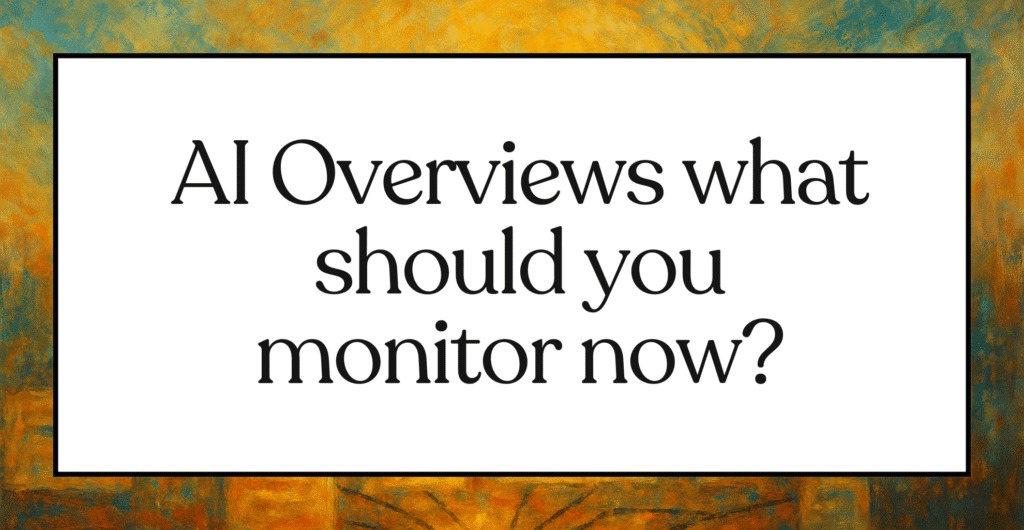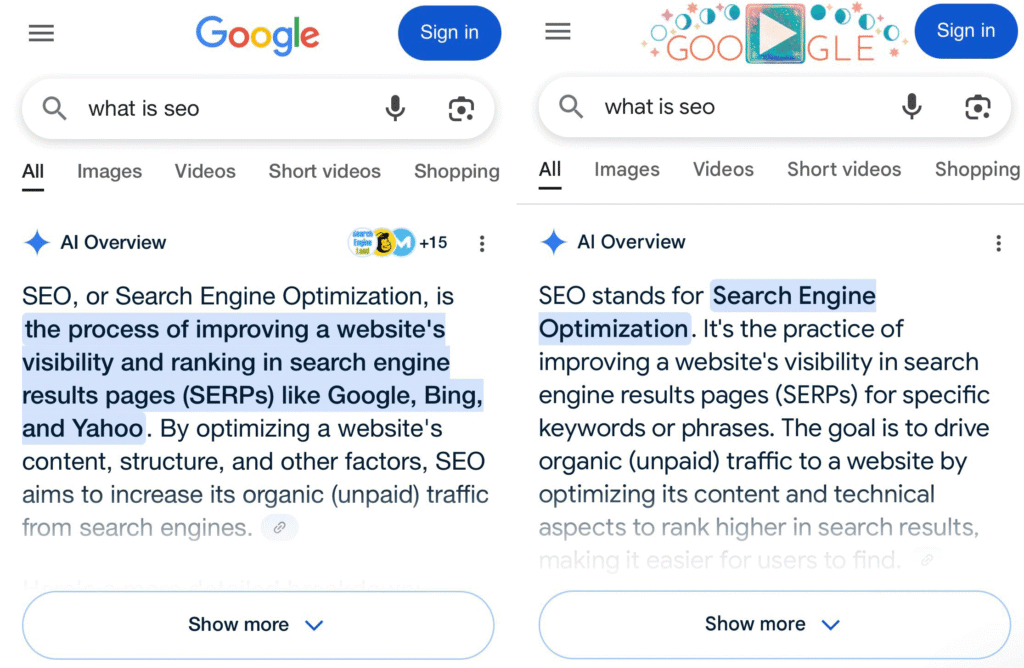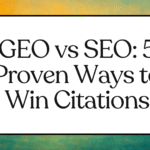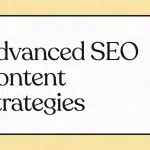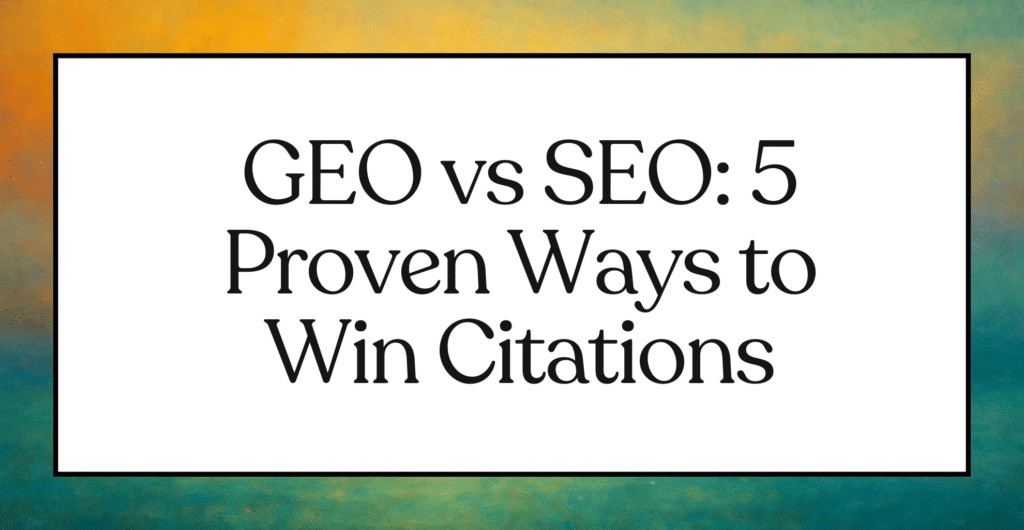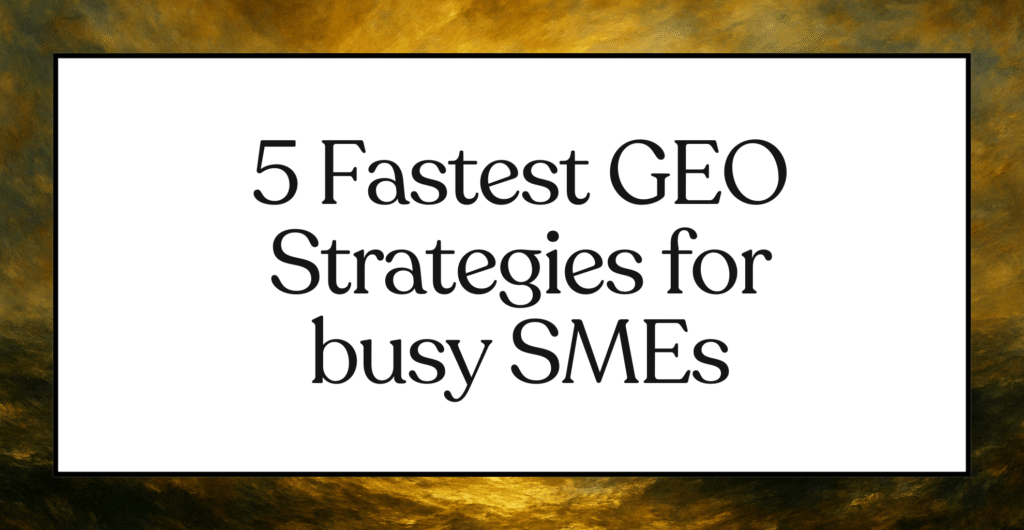AI SERP changes 2025 are not cosmetic. Users get direct answers, citations, follow-ups, and fewer traditional clicks, especially on informational queries. Multiple independent studies now quantify the CTR drop where AI Overviews appear. Ahrefs reports a 34.5 percent CTR decline for the top organic result on affected queries. Search Engine Journal reports a fall from 28 percent to 19 percent for position one after the broader rollout. These signals match publisher accounts and regulator scrutiny.
This article consolidates the current evidence, shows how inclusion and citations are decided, and sets a measurement stack you can run weekly. The lens is practical for African SMEs and agencies, with compare-and-contrast coverage of Google, Bing Copilot Search, and Perplexity.
Our Analysis
Key takeaways on AI SERP changes 2025
- AI Overviews appear on a meaningful share of searches, dominated by informational intent, with commercial coverage rising. Semrush measured 13.14 percent prevalence in March 2025 and 88 percent informational intent in one data cut
- CTR loss concentrates where AI Overviews fire. Ahrefs measured a 34.5 percent drop for top results. A multi-study roundup shows consistent directional decline. Publisher groups in the UK and EU have escalated complaints as traffic cuts mount
- Citation overlap between AI Overviews and classic organic rankings is growing. BrightEdge’s 16-month study shows overlap reaching 54 percent, though variance by vertical remains large.
- Bing Copilot Search blends generative answers with explicit inline citations. The layout differs from Google in where summaries sit and how source lists expand
- Africa context changed in August. Google’s AI Mode rollout hit South Africa, Nigeria, and Kenya, with Google’s global blog stating AI Overviews cover 200 plus countries and 40 plus languages.
Where AI Overviews appear and how often
The latest public datasets put AI Overviews in the low-to-mid teens as a share of searches, mostly informational. Semrush observed 13.14 percent in March 2025 with a heavy informational skew. Conductor’s monthly study tracks prevalence and device effects across 118 million queries, confirming volatility by vertical and month. SISTRIX reports double-digit appearance in some markets like the UK.
Google’s own updates confirm global expansion to more than 200 countries and more than 40 languages, with usage growth tied to AI Mode and AI Overviews. Expect more inventory where queries require multi-step reasoning.
CTR and behavior shifts by query type
Independent datasets align on the direction of click movement:
- Ahrefs: minus 34.5 percent average CTR for position one on informational queries when AI Overviews are present
- Search Engine Journal: top result CTR moving from 28 percent to 19 percent post rollout
- Semrush: informational queries dominate triggering, which maps to zero-click behavior patterns
- Publisher studies and complaints show large traffic impacts, especially for news. UK findings reported steep declines when links sit below summaries
Google maintains that AI features increase overall searches and total site traffic. Its Q3 remarks highlight more AI-led sessions and growth in commercial queries. Treat this as ecosystem-level data that may not reflect outcomes for specific publishers in specific SERPs.
Google vs Bing Copilot vs Perplexity layouts
- Google uses AI Overviews above organic results, with linked sources embedded in the panel and AI Mode as a dedicated tab for conversational follow-ups. Citations appear, yet layout prominence reduces classic result visibility. Expansion to 200 plus countries is official
- Bing Copilot Search merges generative and traditional results with a persistent citation model and expandable cards. Copilot Search is a formal product with Microsoft documentation and rollout notes
- Perplexity is an answer engine with real-time citations at the center of the UI and growing publisher partnerships. Content is synthesized from live pages with visible sources
This divergence matters for planning inclusion strategies and for weekly visibility reports. The same query can cite different brands across engines, as BrightEdge’s cross-platform citation analysis shows.
How to earn inclusion and citations in AI Overviews?
Public documentation states there is no special markup for inclusion. The guidance is to follow Search Essentials and produce helpful, reliable content that can be cited. Evidence from independent analyses highlights these signals: recency, clear entities, and authoritative sourcing at the passage level.
- Freshness windows. Ahrefs analyzed 17 million citations across multiple AI platforms and found a preference for fresher content. Third-party roundups point the same way. Set editorial cadences that support fast refresh in high-change topics
- Entity clarity and structured data. Pages with precise organization and author schema, product markup, and consistent brand entity signals help engines ground answers. Multiple industry guides show improved citation likelihood with better semantic clarity
- Brand mentions and authority. Longitudinal studies show overlap with organic rankings rising to 54 percent, and cross-engine tests show brand citation patterns differ. Earned mentions in credible sources strengthen the signals that AI systems surface
Signals that matter now, from freshness to branded mentions
Priority signals for 2025:
- Recency index. Publish new or refreshed answers within hours or days for fast-moving topics. Ahrefs’ large-scale citation study indicates stronger propensity to cite fresher materials
- Passage extractability. Dense answers with definitions, steps, and evidence increase the chance that a model quotes and cites you. Industry evidence shows AI Overviews pull from deep sections, not only homepages
- Entity disambiguation. Author, organization, product, and location schema helps grounding. Consistent names and IDs across site, GBP, Wikidata, and social profiles reduce ambiguity
- Branded mentions in credible sources. Cross-engine studies show differences in which brands are recommended. Earning mentions on trusted sites correlates with citation probability
Local AI SERP changes for African SMEs
AI Mode is live in South Africa, Nigeria, and Kenya. For local service queries, AI experiences are starting to summarize options and cite sources alongside map units. Expect more conversational flows that incorporate ratings, attributes, and first-party details.
Availability follows Google’s May expansion to 200 plus countries and more than 40 languages, with usage uplift reported in official updates. This unlocks a meaningful testbed for African brands to shape early inclusion patterns while competition is thinner.
For SMEs, the constraints are real. Connectivity costs and uneven access shape what can be refreshed and how often. Plan shorter, high-impact updates that meet freshness thresholds on core products and services instead of broad rewrites.
Metrics to track AI-first visibility weekly
Track classic SEO, then add AI-first KPIs. Use these as the minimum viable set:
- AIO inclusion rate: percentage of target keywords where your brand is cited inside AI Overviews or Copilot summaries. Conductor and SISTRIX publish trackers that model prevalence and layout
- Citation share by engine: number of AI citations to your site divided by total citations for your tracked topics across Google, Bing, and Perplexity. BrightEdge’s insights show overlap patterns that change by vertical
- Time to first citation: hours from publish or refresh to the first observed AI citation on tracked terms. Calibrate your editorial cadence to the observed decay curve in citation freshness studies
- CTR by layout: compare clicks on pages with and without AI Overviews present. Use Search Console filters and controlled samples to isolate AIO impact, aligned with external CTR studies
- Local coverage rate: share of GBP categories and location queries that get summarized mentions. Pair with geo-grid rank data where available
- Brand mention velocity: net new credible brand mentions per week across authoritative domains that AI systems often cite. Use these as leading indicators for citations inside AI answers
Tooling to monitor AI search visibility across engines
- Conductor AIO analysis for 118M keywords, with visibility reporting on AIO and AI Mode
- BrightEdge Weekly AI Search Insights for overlap, vertical deltas, and citation composition
- SISTRIX AI Overview Hub to track AIO presence across countries plus filters for layout analysis
- Semrush AIO Study for prevalence, intent splits, and zero-click context
- Bing Copilot Search documentation for layout and citation behavior when building comparative dashboards
- Perplexity publisher and review coverage to understand citation mechanics and partnerships
Playbook for SMEs and agencies in 30, 60, 90 days
Days 1–30: Baseline and hardening
- Build a tracked keyword set by intent. Flag informational queries that already trigger AI Overviews. Add a 5 to 10 keyword local pack for each priority city or neighborhood
- Instrument inclusion and citation tracking across Google, Bing Copilot, and Perplexity. Log AIO presence, position on the page, cited URL, and date seen
- Refresh cornerstone pages with extractable passages and entity markup. Ensure author and organization schema is complete and consistent with GBP
Days 31–60: Freshness cadence and brand mentions
- Establish a weekly refresh loop on high-change topics to match freshness preference patterns
- Pursue earned placements on credible regional publishers and vertical authorities that AI systems already cite. Track brand mention velocity as a leading indicator for AI citation gains
- Expand local content with city and neighborhood variants tied to real attributes that models can ground, like pricing, eligibility, and service hours
Days 61–90: Comparative optimization and scaling
- Compare citation share across engines. Build A/B tests around passage structure, FAQ density, and schema variations. Measure shifts in AIO inclusion over two to four weeks
- Map CTR by layout presence using Search Console and analytics. Isolate changes where AI Overviews appear. Cross-reference with external CTR studies for context
- For African markets, prioritize AI Mode queries and mobile experiences. Monitor rollout notes and expand coverage to nearby countries as availability increases
Risks, policies, and compliance checkpoints
- Quality issues and hallucinations can tarnish brand trust if models misstate facts using your content. Google has issued fixes and narrowed triggers after high-profile errors, yet monitoring remains essential
- Ecosystem tension with publishers is ongoing. Studies cite steep traffic drops and complaints have reached regulators in the UK and EU. This can catalyze layout or policy changes. Keep change budgets ready
- Product changes like AI Mode, Audio Overviews, and new ad formats can shift attention. Follow official posts and reputable tech press for rollout details
What changes next in the coming 6 to 12 months
Expect more conversational flows, wider AI Mode access, and deeper integration with bookings and transactions. Microsoft is pushing Copilot across surfaces. Google reports query growth and is iterating on personalization for AI Mode users. Perplexity continues to formalize publisher partnerships that clarify rights and revenue. Plan quarterly audits of inclusion, layout shifts, and vertical-specific changes.
Recommendations
- Write for extractability
Structure pages with crisp definitions, numbered steps, and short evidence-rich passages that can stand alone as quotes. Add FAQs that answer the exact questions your buyers ask. This aligns with how AI Overviews and Copilot summarize and cite - Operationalize freshness
Adopt weekly refreshes on top pages and time-sensitive posts. Track time to first citation as a KPI and tune cadence for categories that decay fastest - Strengthen entity signals
Complete Organization, Author, Product or Service, and LocalBusiness schema. Align names and IDs across GBP, social profiles, and knowledge sources to cut ambiguity - Earn credible brand mentions
Target publications and industry hubs your audience already trusts. BrightEdge shows cross-engine differences in which brands get cited. Treat PR and partnerships as GEO inputs, not afterthoughts - Measure AI-first visibility
Stand up a weekly report with AIO inclusion rate, citation share by engine, time to citation, CTR by layout, local coverage rate, and brand mention velocity. Use Conductor, BrightEdge, and SISTRIX for tracking, plus manual spot checks - Local playbook for African SMEs
Optimize GBP, prioritize mobile speed, and publish concise city and neighborhood pages with pricing and proof. Monitor AI Mode availability and test follow-up prompts that reference local constraints - Scenario plans for CTR loss
Where AI Overviews cannibalize clicks, move the win upstream. Publish comparison tables, calculators, and buyer guides that models cite. Track assisted conversions from cited pages to avoid under-valuing visibility
AI SERP changes 2025 are durable. The play is not to chase hacks. Treat inclusion and citations like a measurable funnel. Publish extractable answers. Refresh on a clock. Clarify entities. Earn the right mentions. Track AI inclusion like a product metric, then iterate with intent-level tests. Your advantage compounds when the cadence is real and the measurements are visible.
Sources
AI Overviews Reduce Clicks by 34.5%, Ahrefs, 2025-04-17 – https://ahrefs.com/blog/ai-overviews-reduce-clicks/
New data: Google AI Overviews are hurting click-through rates, Search Engine Land, 2025-04-21 – https://searchengineland.com/google-ai-overviews-hurt-click-through-rates-454428
Google CTRs Drop 32% For Top Result After AI Overview Rollout, Search Engine Journal, 2025-07-21 – https://www.searchenginejournal.com/google-ctrs-drop-32-for-top-result-after-ai-overview-rollout/551730/
Semrush Report: AI Overviews’ Impact on Search in 2025, Semrush, 2025-07-22 – https://www.semrush.com/blog/semrush-ai-overviews-study/
AI Overview Citations Now 54% from Organic Rankings, BrightEdge, 2025-09-18 – https://www.brightedge.com/resources/weekly-ai-search-insights/rank-overlap-after-16-months-of-aio
AI Overview Analysis & Study: Updated September 2025, Conductor, 2025-09-01 – https://www.conductor.com/academy/ai-overviews-analysis/
AI Overviews expand to over 200 countries and territories, more than 40 languages, Google, 2025-05-21 – https://blog.google/products/search/ai-overview-expansion-may-2025-update/
AI Mode in Google Search: Updates from Google I/O 2025, Google, 2025-05-20 – https://blog.google/products/search/google-search-ai-mode-update/
AI Features and Your Website, Google Search Central, 2025-06-19 – https://developers.google.com/search/docs/appearance/ai-features
Introducing Copilot Search in Bing, Bing Search Blog, 2025-04-04 – https://blogs.bing.com/search/April-2025/Introducing-Copilot-Search-in-Bing
Microsoft officially launches Copilot Search in Bing, Search Engine Land, 2025-04-04 – https://searchengineland.com/microsoft-officially-launches-copilot-search-in-bing-453958
Artificial intelligence: Le Monde signs partnership agreement with Perplexity, Le Monde, 2025-05-14 – https://www.lemonde.fr/en/about-us/article/2025/05/14/artificial-intelligence-le-monde-signs-partnership-agreement-with-perplexity_6741262_115.html
Google’s test turns search results into an AI-generated podcast, The Verge, 2025-07-03 – https://www.theverge.com/news/686904/google-audio-overviews-ai-podcast-search
New Study: AI Assistants Prefer to Cite “Fresher” Content, Ahrefs, 2025-08-12 – https://ahrefs.com/blog/do-ai-assistants-prefer-to-cite-fresh-content/
How Different AI Search Engines Choose Which Brands to Recommend, BrightEdge, 2025-09-05 – https://www.brightedge.com/resources/weekly-ai-search-insights/how-different-ai-search-engines-choose-which-brands-to-recommend
Data Shows Google AIO Is Citing Deeper Into Websites, Search Engine Journal, 2025-04-05 – https://www.searchenginejournal.com/data-shows-google-aio-is-citing-deeper-into-websites/543325/
Google rolls out advanced AI Mode in South Africa, Nigeria and Kenya, TechCentral, 2025-08-21 – https://techcentral.co.za/google-rolls-out-advanced-ai-mode-in-south-africa-nigeria-and-kenya/268933/
Google Search: Introducing AI Mode in Africa, Google Africa, 2025-08-21 – https://blog.google/intl/en-africa/products/explore-get-answers/google-search-introducing-ai-mode-in-africa/
